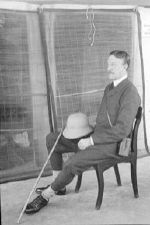Beatson: Difference between revisions
Jump to navigation
Jump to search
No edit summary |
No edit summary |
||
| Line 1: | Line 1: | ||
[[File:Stuart Beatson.jpg|right|150px|thumb|Stuart Beatson as a Major General]] | |||
According to [[Readers Guide to The Mahatma Letters to A. P. Sinnett (book)|''Readers Guide to The Mahatma Letters to A. P. Sinnett'']]:<br> | According to [[Readers Guide to The Mahatma Letters to A. P. Sinnett (book)|''Readers Guide to The Mahatma Letters to A. P. Sinnett'']]:<br> | ||
<blockquote> | <blockquote> | ||
| Line 5: | Line 6: | ||
He was present at the dinner party where the first of the [[Brooch (phenomenon)|brooch phenomena]] took place. | He was present at the dinner party where the first of the [[Brooch (phenomenon)|brooch phenomena]] took place. | ||
By 1897 he was a major, commanding the 11th Bengal Lancers, known as "Beatson's Horse," in a battle at Malakand. Eventually he achieved the rank of major general.<ref>[https://oac.cdlib.org/ark:/13030/kt2z09r0gg/?brand=oac4 Online Archive of California].</ref> | |||
== Notes == | == Notes == | ||
Latest revision as of 19:44, 23 September 2024
According to Readers Guide to The Mahatma Letters to A. P. Sinnett:
Beatson, Mr., a young officer of the Bengal Cavalry. He was at Simla, India in October 1880 at the time of the visit of the Founders, when so many phenomena where produced through HPB. He joined the TS at that time. he is said to have missed out on advancement in the army due to favoritism. Became much interested in occultism. LBS, p. 27.[1]
He was present at the dinner party where the first of the brooch phenomena took place.
By 1897 he was a major, commanding the 11th Bengal Lancers, known as "Beatson's Horse," in a battle at Malakand. Eventually he achieved the rank of major general.[2]
Notes
- ↑ George E. Linton and Virginia Hanson, eds., Readers Guide to The Mahatma Letters to A. P. Sinnett (Adyar, Chennai, India: Theosophical Publishing House, 1972), 219.
- ↑ Online Archive of California.
